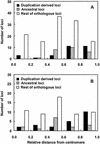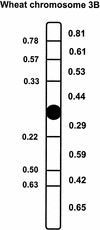The organization and rate of evolution of wheat genomes are correlated with recombination rates along chromosome arms
- PMID: 12695326
- PMCID: PMC430889
- DOI: 10.1101/gr.808603
The organization and rate of evolution of wheat genomes are correlated with recombination rates along chromosome arms
Abstract
Genes detected by wheat expressed sequence tags (ESTs) were mapped into chromosome bins delineated by breakpoints of 159 overlapping deletions. These data were used to assess the organizational and evolutionary aspects of wheat genomes. Relative gene density and recombination rate increased with the relative distance of a bin from the centromere. Single-gene loci present once in the wheat genomes were found predominantly in the proximal, low-recombination regions, while multigene loci tended to be more frequent in distal, high-recombination regions. One-quarter of all gene motifs within wheat genomes were represented by two or more duplicated loci (paralogous sets). For 40 such sets, ancestral loci and loci derived from them by duplication were identified. Loci derived by duplication were most frequently located in distal, high-recombination chromosome regions whereas ancestral loci were most frequently located proximal to them. It is suggested that recombination has played a central role in the evolution of wheat genome structure and that gradients of recombination rates along chromosome arms promote more rapid rates of genome evolution in distal, high-recombination regions than in proximal, low-recombination regions.
Figures







References
-
- Altschul S.F., Gish, W., Miller, W., Myers, E.W., and Lipman, D.J. 1990. Basic local alignment search tool. J. Mol. Biol. 215: 403-410. - PubMed
-
- Anderson J.A., Ogihara, Y., Sorrells, M.E., and Tanksley, S.D. 1992. Development of a chromosomal arm map for wheat based on RFLP markers. Theor. Appl. Genet. 83: 1035-1043. - PubMed
-
- Bernardi G. 1996. The organization of the human genome. Chemicke Listy 90: 549-553.
-
- Bernardi G., Hughes, S., and Mouchiroud, D. 1997. The major compositional transitions in the vertebrate genome. J. Mol. Evol. 44: S44-S51. - PubMed
Publication types
MeSH terms
Substances
LinkOut - more resources
Full Text Sources
